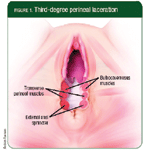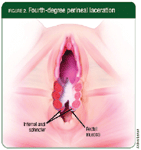Grand Rounds: Managing future pregnancies after a severe perineallaceration
What do you tell a pregnant patient with a previous third- orfourth-degree tear, for whom another vaginal delivery raises therisk of further injury? Can some women safely have a trial oflabor? Diagnose occult tears with ultrasound, advise theseexperts-and use it to assess the anal sphincters of allincontinent women.
The advice you give a pregnant patient who has suffered an anal sphincter laceration during a previous delivery can have a critical impact on her quality of life. With another vaginal birth, she's more likely to suffer a repeat anal sphincter tear and worsening symptoms of anal incontinence. Sexual dysfunction may also be at stake. Despite all this, there are no easy answers, because the best way to manage a subsequent pregnancy of a woman with a previous tear is controversial.




[Five key risk factors of severe lacerations are: (1) Midline episiotomy, (2) Forceps or vacuum delivery (vacuum being less traumatic than forceps), (3) Asian ancestry, (4) High birthweight, and (5) First birth.4,6,7]
